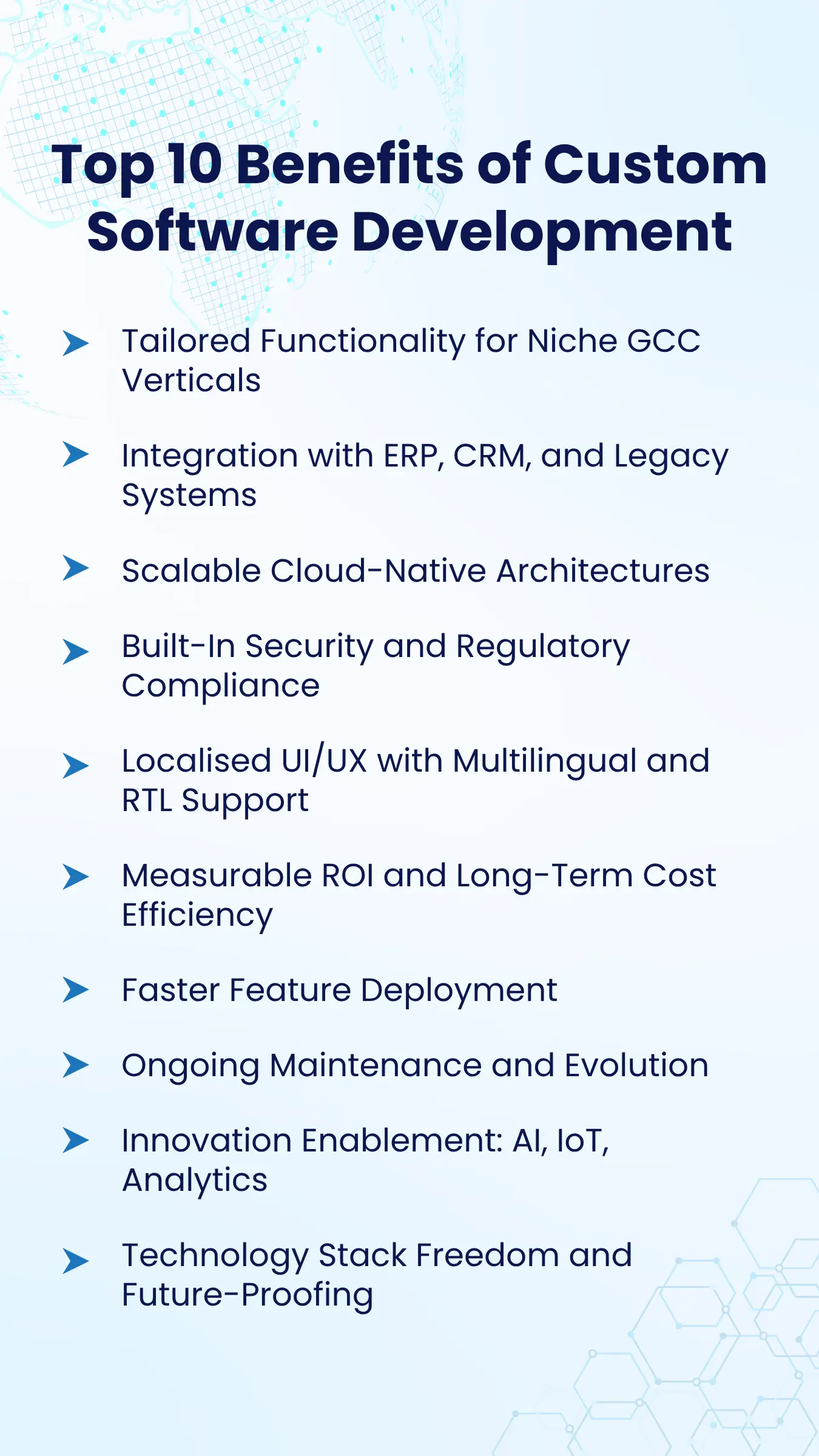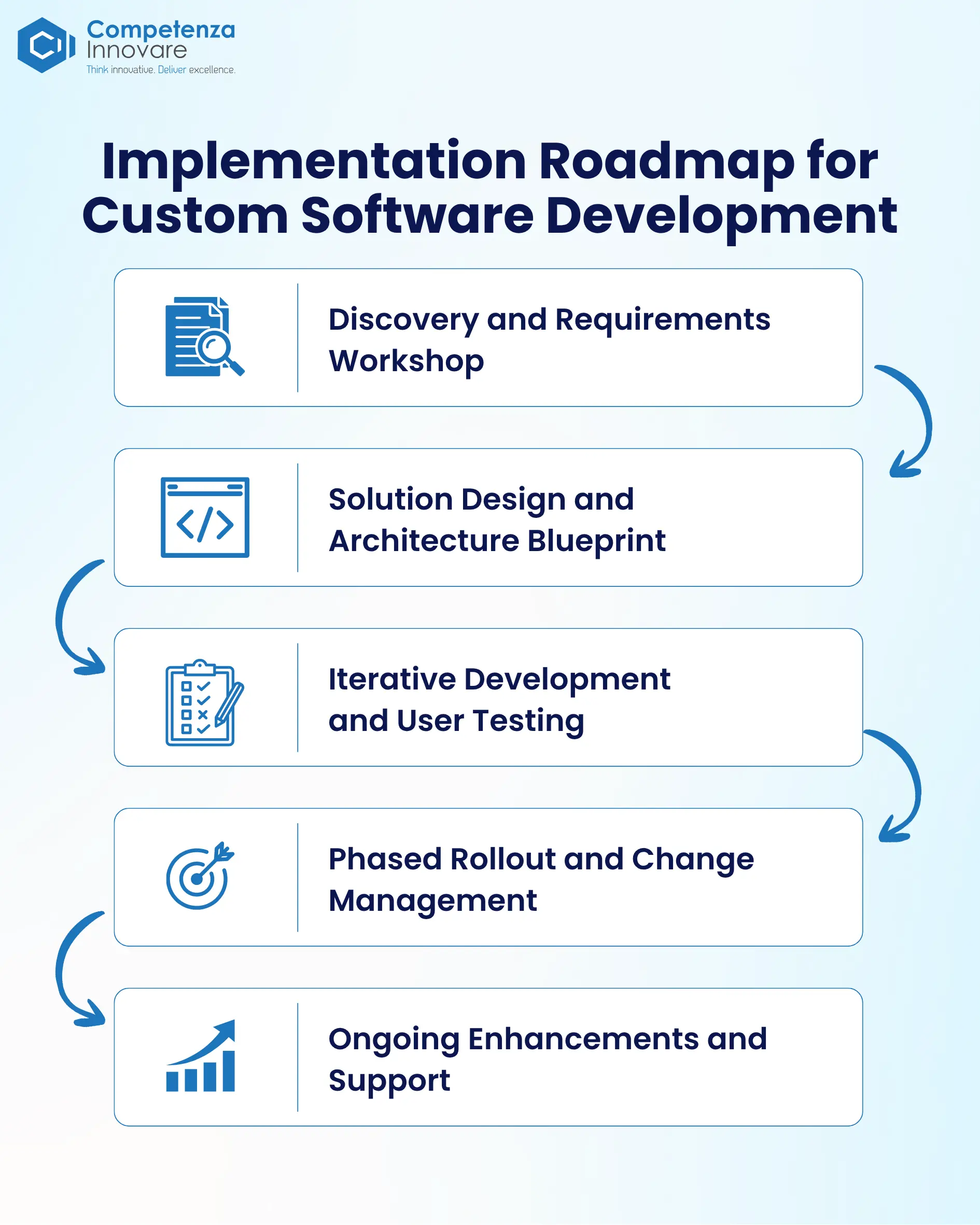At A Glance
- Custom software development allows GCC companies to build their digital tools around how they actually operate, rather than adapting business processes to generic systems.
- As data residency and regulatory frameworks like Saudi Arabia’s PDPL and the UAE’s cloud compliance rules become more important, custom software is becoming a more reliable way to move forward.
- Pre-built software solutions in the market either do not support GCC-specific data residency laws, language requirements, etc., or require third-party integrations.
- Custom software allows IT leaders to prioritise exact features and deployment methods, avoiding unnecessary licensing fees and less necessary modules.
Introduction
Today we see technology upgrade & change rapidly, and businesses need every edge they can get to stay competitive in the market.
Custom software development gives organisations more control over their software & internal systems, over their data, and how the teams operate.
When they’re just getting started, many companies in the GCC go with ready-made software solutions. It’s easy to roll out and seems to cover most of what they need.
But once the business grows, things begin to shift, especially when it comes to data localization, integrations with existing & third-party tools, or multilingual support.
In regulated industries like healthcare or finance, these gaps are harder to work around. Teams need specific workflows that are not available in standard software solutions.
That’s usually when custom software is a practical option. Instead of bending processes to fit generic tools, businesses start building the functions they need and stop spending time and budget trying to make packaged platforms do something they weren’t built for.
Custom software development gives a chance to build software solutions that are flexible to the organizational needs with full control over updates and fixes.
In this blog, we’ll discuss the benefits that custom software offers to businesses.
Top 10 Benefits of Custom Software Development
Businesses usually don’t start out planning to build their own software. The decision to build custom software starts with a specific problem, a feature that is not available in the existing tool. It could also be a missing workflow, not-so-effective integration options, or a compliance risk tied to local regulations.
But when explored further, custom software offers a longer list of benefits from the new functionalities being looked at and the effect it can have on how teams work.
Let’s look at the benefits of custom software development in more detail.

1. Tailored Functionality for Niche GCC Verticals
The majority of pre-built software solutions are designed for international use rather than the day-to-day operations of GCC industries like retail, construction, and logistics.
A Saudi Arabian construction company may require custom software for the permit-tracking process that is similar to the local process for municipal approvals.
Custom software for invoicing that can switch between Arabic and English and apply VAT according to location may be necessary for a retail company in the United Arab Emirates.
These features aren’t typical. They are not pre-installed.
They must be purposefully built.
With custom software, teams can build tools that align with their existing workflows and how they already work. That can include not just workflows, templates, and compliance logic but data storage, multi-tenant capability, etc
2. Integration with ERP, CRM, and Legacy Systems
Most growing businesses in the GCC use a mix of systems. ERPs like SAP, CRMs, finance tools, and internally developed databases.
Over time, these systems are adjusted to fit how the organization runs or to meet the regional compliance standards.
If a new software doesn’t integrate properly with what’s already in use, teams start facing issues. Data is entered twice in different places. Reports don’t line up. Processes stall while teams manually move information from one system to another.
Custom software helps avoid this by building those connections into the system from day one. Whether it’s integrating with SAP, Oracle, or analytics tools, the custom software are designed and built to understand how that data should move between different systems.
It prevents rework, reduces errors, and allows for more consistent reporting across departments. It also saves the IT teams from relying on third-party connectors that can break or pose security risks.
3. Scalable Cloud-Native Architectures
Companies’ systems have to manage more data and more services across multiple regions as they expand and add more users. Traffic can increase during promotional events, seasonal campaigns, or market expansion; this growth isn’t linear.
Standard software solutions often run into performance issues during these moments. Some modules slow down. Others crash under pressure. Businesses either end up overpaying for unused server capacity or struggling to meet demand during peak usage.
A more adaptable strategy is provided by custom software. An application that is cloud-native can adapt to demand on its own. The system can scale its response to spikes in usage.
Resources can also scale down when demand declines, preventing waste. This setup is useful for companies in the GCC regions, where some markets require local data hosting. A cloud-native solution can be deployed regionally to meet compliance requirements while still managing performance efficiently.
4. Built-In Security and Regulatory Compliance
Security and compliance are often treated as extras in pre-built software solutions. You change settings, buy plugins, or add third-party tools to meet local needs.
But in the GCC, especially in sectors like healthcare, fintech, and logistics, this can create gaps.
With custom software, you can address security and compliance right from the beginning through planning, design, and development. This includes deciding how data is stored, who can access it, where it’s hosted, and how it moves between systems.
For example, a custom software made for Saudi Arabia can follow PDPL from the beginning, instead of depending on external fixes after deployment. Role-based access, encryption standards, and audit trails are directly integrated into the platform based on organization functions.
This not only assists with regulatory inspections but also lowers the risk of operational issues from misconfigured tools and scattered data policies.
5. Localised UI/UX with Multilingual and RTL Support
Most international software platforms are designed for English-speaking, left-to-right user interfaces. In the GCC, that doesn’t always work. Many teams operate in bilingual environments, and public-facing platforms need to prioritise Arabic-first interfaces.
This gap shows up quickly—menus that don’t display correctly in right-to-left format, labels that aren’t translated, or user roles that can’t switch languages without logging out. This affects usability and user adoption.
When the software is custom-built, the user interface can be shaped around the users to be.
This is very important for mass user-facing platforms like e-commerce websites, booking systems, or customer support platforms.
For example, a bilingual user interface isn’t only about accessibility; it can improve conversion rates and overall user satisfaction.
Internal software solutions also gain benefits. Staff in warehouses, clinics, or fields can use the custom software in their preferred language, which also helps in reducing training times for team members and errors while operating.
6. Measurable ROI and Long-Term Cost Efficiency
Pre-built software solutions are mostly quick to set up and reasonably priced; many businesses begin with them. But once the system is in use, extra costs begin to show. Teams end up paying for features they don’t actively use, hiring consultants to handle configurations, or adding licences as departments grow.
For businesses in the GCC, these costs increase even more when localisation becomes an issue. A company that operates in both Saudi Arabia and the UAE will need separate tools just to meet hosting rules or language preferences.
With custom software, costs are more visible. The development is scoped around what the business needs—not what a vendor bundles into a package. Custom software features can be built in stages, rolled out by priority, and modified without depending on a third-party roadmap.
It’s also easier to see what you’re getting back. If a company builds custom software that cuts down the hours spent reconciling invoices each week, the gains aren’t hard to measure.
You can tie the outcome directly to how people spend their time and where delays used to happen.
7. Faster Feature Deployment
The time taken to make a requested feature available in pre-built software solutions is a limitation. Companies sometimes wait for months.
Even small updates take time because there is a process involved and also require enough users for the vendor to make it available.
Custom software development can have a flexible release process. With an agile setup, new features can be designed, tested, and rolled out in smaller sprints. This makes it easier to respond to internal feedback, adjust features during the development process, and deliver updates without having to wait for a full system upgrade.
It’s a setup that gives IT teams more control and gives business units what they need when they need it.
8. Ongoing Maintenance and Evolution
When the custom software goes live, teams start seeing what needs to change—small fixes, layout tweaks, or mini-features that were missed in planning.
In pre-built software solutions, getting those changes done usually means external support, vendor requests, etc.
Custom software is easy to adapt. It is also easier for the development partner to make updates, even the ones that were not in the original scope, as they know the system well. Being able to make updates easily helps to adapt to any regional compliance.
The custom software development partner already understands the context it was built for. That makes it easier to keep things running smoothly, respond to user feedback, and add features as the business changes.
“The ability to adapt software after go-live is often the difference between early impact and long-term success.”
– Deloitte Tech Trends report
9. Innovation Enablement: AI, IoT, Analytics
Digital transformation isn’t only about refining old processes but also about building space for what’s next. AI, IoT, and data analytics are now part of regular business planning in sectors like manufacturing, logistics, and healthcare.
In a pre-built software solution, automating processes can become a hurdle if the API architecture of the software is rigid.
With custom software, it’s easier to build around specific use cases.
For example, a logistics company could use custom software where every shipment generates real-time sensor data and feeds it into a dashboard that predicts delivery delays.
Or a healthcare company could introduce AI triage tools that can access data from patient histories without ever exporting data outside of the platform.
The point isn’t just to add technology but to design systems that make room for innovation without disrupting what already works.
10. Technology Stack Freedom and Future-Proofing
When you use off-the-shelf software, you also take on the vendor’s tech choices—language, hosting, integration limits. At first, it is manageable. But later, these choices shape everything from cost to compliance.
It also limits flexibility, say, when a business wants UI updates, add new modules, or shift to a different cloud provider. And these are long-term constraints that usually either don’t become available or require sufficient time.
Custom software puts these decisions back in the business’s hands. You choose the stack. You choose the infrastructure. You decide when to upgrade and how much control to keep in-house.
It also easier to maintain the software over time. As systems evolve, teams won’t be tied to a vendor’s roadmap, they can update, migrate, or expand based on their priorities.
Implementation Roadmap for Custom Software Development
Custom software development moves through stages. Internal feedback at every stage helps teams make decisions with more clarity, avoid unnecessary rework, and stay aligned.
Here are the steps to follow to build a custom software:
1. Discovery and Requirements Workshop
This is where everything starts. For every software solution, business and technical teams sit down to map out what the software needs to do. It’s not just about listing features but understanding the changes needed in the current processes.
Teams also identify the compliance rules, performance needs, or integration setups early on.
2. Solution Design and Architecture Blueprint
Once the requirements are clear, software architecture is built – a blueprint that shows how data will move between systems, what kind of infrastructure will be used, and how the security setup should look.
The design stage allows for experimenting with UI/UX, what the user journey should feel like, and how different user roles interact with the software.
Alongwith the visuals it is made sure that the workflows are clear, the interface makes sense for both Arabic and English users, etc.
3. Iterative Development and User Testing
We start by defining which technologies will be used and how the software will scale over time.
Then the development starts, It’s developed in smaller parts, mostly referred to as modules in two- to three-week cycles. Teams review each part as it’s delivered, test how it works, and share feedback. This approach keeps the project flexible. If something isn’t working as expected, it can be changed before the next stage starts.
4. Phased Rollout and Change Management
5. Ongoing Enhancements and Support
Once the software is in use, new needs appear as a new regulation update or internal team’s feature addition requirement. Because the system is custom-built, updates can be made without disrupting the entire platform.
Your development partner team also monitor performance and resolve issues before they become major problems.

How Competenza Can Help with Custom Software Development in the Middle East
Competenza works with businesses across the GCC to plan, build, and maintain custom software that fits local regulations, internal systems, and long-term goals. Our delivery model is designed to move fast, reduce risk, and stay aligned with how your teams actually work.
1. Expertise Across Modern Tech Stacks
Our team at Competenza has implementation expertise with technologies like .NET, Java, Node.js, React, and mobile frameworks like flutter, alongside cloud platforms such as AWS and Azure.
Our role isn’t to push a particular stack but to help our client partners choose what suits their goals and future roadmap
2. A Delivery Process That’s Built for Clarity
Each engagement starts with a technical audit and requirements workshop. We then build a blueprint of the timeline & modules to be developed and plan agile sprints. This provides our clients access to test the features early, give feedback, and remove last-minute surprises during rollout.
3. Compliance Handled from the Start
Our team is familiar with regulatory frameworks across the region—Saudi Arabia’s PDPL, UAE’s cloud laws, ISO 27001, and GDPR. We account for these from day one, designing systems that meet legal requirements without slowing the business down.
4. Industry-Specific Demos Before Development Starts
Before coding begins, we run walkthrough sessions with reference demos based on your industry. This gives teams a chance to see similar use cases in action and raise questions before anything is committed to development.
Conclusion
Custom software development offers more than just flexibility—it helps create systems that match real operational needs, align with local compliance rules, and scale without unnecessary complexity.
The benefits aren’t just technical. Teams work more efficiently, reporting becomes clearer, and companies avoid the long-term cost and limitations of trying to stretch packaged tools beyond their purpose.
When software is built particularly for a business and to support its operations, the results show up in day-to-day performances and in how smoothly the business runs.
Explore and discuss custom software solution requirements for your organisation with a free audit session with the Competenza team.
We’ll review the current systems, assess your requirements, and map out what a purpose-built solution could deliver based on your goals.
Contact Competenza to book your session.
FAQs
What makes custom software development a better fit than pre-built platforms for businesses in the GCC?
Most off-the-shelf software tools are built for general use. They don’t reflect how companies in this region operate day to day. With custom software, you’re not working around missing features or trying to localise something that was built for a different market. You’re building from the ground up—based on your own workflows, language needs, and regulatory environment.
How does custom software help meet data compliance in places like Saudi Arabia or the UAE?
Different countries in the GCC have introduced strict rules on where and how data can be stored. Off-the-shelf platforms might not support local hosting or role-based access in the way you need. Custom software lets you make those decisions from the start—how data is handled, who has access, where it’s stored—and build it into the system, not tack it on later.
Is custom software always more expensive?
Not always. It depends on what you need and how much time your team is spending working around the tools you have. Ready-made platforms can seem cheaper upfront, but once you start paying for extra licences, integrations, or consultants, the cost adds up. With custom software, you pay for what you actually use—and you’re not locked into a pricing model that doesn’t scale well.
Can we connect custom software to our existing tools like SAP or Salesforce?
Yes. In fact, that’s one of the biggest advantages. You’re not stuck trying to force an integration that wasn’t meant to work. Custom development means you can build the software to connect cleanly to your ERP, CRM, or internal databases, using the formats, logic, and workflows you already rely on.
What makes custom software better for innovation and emerging tech?
If you’re looking to use AI, IoT, or build custom dashboards, packaged software usually slows you down. You have to wait for the vendor to support those features—or buy something else and try to link it in. Custom software gives you the freedom to plan for those technologies early. You can structure your data and build the system so that it’s ready to support what comes next, not just what’s already in place.
How long does it take to get custom software up and running?
There’s no one answer; it depends on how complex the system is. But you don’t have to wait until the whole thing is finished to start using it. Most companies release parts of the software in phases. You get working features early, test them in real conditions, and adjust along the way. That way, your teams don’t sit idle, and you’re not guessing what’s going to work. In general, custom software takes 4-8 months to build once requirements are locked.







